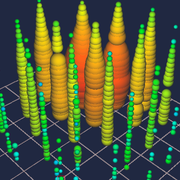
Sixty years ago, a postdoctoral researcher at what is now known as the Niels Bohr Institute in Denmark named Sheldon Glashow proposed a hypothetical interaction between electron antineutrinos and atomic electrons, which would produce a yet-unknow particle through a resonance process. Twenty years later, this particle, known as the W-boson, was discovered by the UA1 experiment at CERN. The discovery was so important that it lead to a shared Nobel Prize in Physics for the two key scientists behind it, Simon van der Meer and Harvard Higgins Professor of Physics Carlo Rubbia, and only a year later.
But Professor Glashow, Nobel laureate and Emeritus Professor at Harvard would have to wait another forty years for his proposed interaction to be observed.
This week, researchers at the IceCube Neutrino Observatory, located in the South Pole, presented the first detection of a “Glashow Resonant Event” in an article published in Nature*. The event was recorded on December 6, 2016, and deposited 6.3 PeV of energy in the IceCube detector instrumented volume. No human-made accelerator can produce a particle with such energy (CERN’s Large Hadron Collider can achieve maximum energy that’s a thousand times smaller than is necessary to make this neutrino.) This enormous energy can only be achieved by cosmic accelerators, such as turbulent regions near active supermassive black holes at the centers of galaxies.
"This is a very exciting observation as it confirms another prediction of the Standard Model," commented Harvard Assistant Professor Carlos Argüelles-Delgado, whose work explores properties of neutrinos using data from IceCube. "Though the event was recorded four years ago, significant work was needed to refine our understanding of our detector in order to properly characterize these gigantic events."
“I never imagined my eponymous resonance to be seen sixty years later at the South Pole!” said Professor S. Glashow. “As Pauli responded to the discovery of neutrinos, ’Everything comes to him who knows how to wait.’”
Indeed, with enough patience we can expect to have more observations of Glashow events from IceCube in the future, and a significantly higher event rate in IceCube-Gen2, a proposed extension of the IceCube experiment which will increase its size tenfold. These future observations will enable further tests of the Standard Model and yield unique insights into the nature of cosmic accelerators.
Read the Nature article:*The IceCube Collaboration., Aartsen, M.G., Abbasi, R. et al., "Detection of a particle shower at the Glashow resonance with IceCube," Nature 591 (2021). https://doi.org/10.1038/s41586-021-03256-1
Also read the IceCube press release: IceCube detection of a high-energy particle proves 60-year-old theory.
